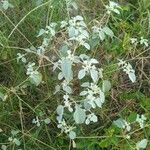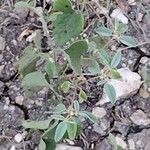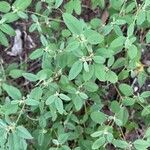Herbs, annual, 2–5 dm, monoecious. Stems dichotomously branched from near base, stellate-hairy, some stellate hairs with dark brown centers. Leaves sometimes clustered near inflorescences; stipules glandlike, 0.1–0.3 mm; petiole 0.3–1.5 cm, glands absent at apex; blade ovate-oblong to nearly round (proximal) to narrowly elliptic (distal), 1–3.5 × 0.5–3 cm, base obtuse to rounded or truncate, margins entire, apex rounded to acute, abaxial surface pale green, sparsely whitish stellate-hairy and appearing brown-dotted, some hairs with dark brown centers, adaxial surface darker green, densely stellate-hairy, hairs without brown centers. Inflorescences bisexual or sometimes pistillate, congested racemes, 0.3–1 cm, staminate flowers 3–10, pistillate flowers 1–2(–5). Pedicels: staminate 0.5–2 mm, pistillate 1–2.5 mm (2–3 mm and recurved in fruit). Staminate flowers: sepals 3–5, 0.7–1 mm, abaxial surface stellate-hairy; petals 3–5, narrowly elliptic-oblanceolate, 0.7–1 mm, abaxial surface glabrous except margins villous; stamens 3–5. Pistillate flowers: sepals 5, subequal, 1.5–2 mm, margins entire, apex straight to slightly incurved, abaxial surface stellate-hairy, some hairs with dark brown centers; petals 0; ovary 2-locular, 1 fertile; styles 2, 0.8–1.2(–1.5) mm, 2-fid to base, terminal segments 4. Capsules appearing follicular (1-seeded), 3.5–4.5 × 1.8–2.2 mm, smooth; columella ± curved, apparently deciduous upon dehiscence of capsule. Seeds 2.5–3.3 × 2–2.5 mm, shiny. 2n = 20.
More
Annual, 2–6 dm, widely dichotomously branched, the lowest branches often 3–5 together; lvs ovate or ovate-oblong, 1–4 cm, entire, blunt or apiculate, broadly rounded to truncate at base, silvery-green and rather densely stellate; infls less than 1 cm; staminate fls minute, with 3–5 sep and pet and 3–8 stamens; pistillate fls with 5 sep and no pet, becoming reflexed; ovary bilocular, one locule later abortive; styles 2, deeply bifid; seed 1; 2n=16. Dry or sterile soil; O. to Io., Neb., and Colo., s. to Fla., Tex., and n. Mex.; occasionally adventive farther n. or e.



